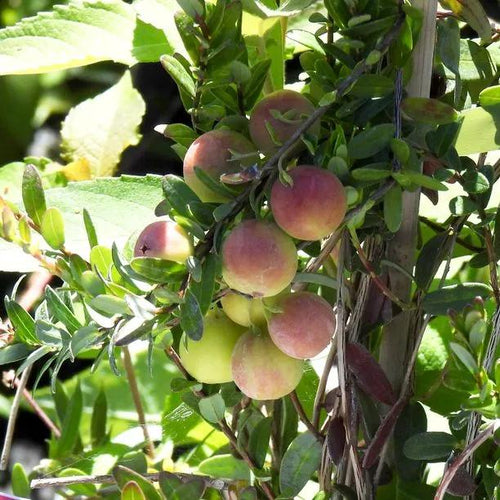Pilgrim American Cranberry Plants
If you like a tart little berry, fresh cranberries are superb off the branch. For everyone else, there are cranberry juices, smoothies, jellies, jammy cake layers, yoghurt toppings, and chewy dried ones in your porridge.
A spreading and trailing plant with lax stems, ideal for the edge of containers of blueberries and other acid loving plants, Pilgrim tolerates partial shade well and easily squeezes into awkward corners and crannies. The evergreen leaves turn bronze in winter, and look so handsome with the berries on mature plants that some people don't bother to pick them and let them hang on into winter for their ornamental value alone! The flowers are tiny, but butterflies are still drawn to them.
Browse all of our soft fruit here.
Features
- Tart red fruit are usually preserved rather than eaten fresh, but are excellent with yoghurt.
- Trailing habit, ideal for the edge of containers of blueberries
- Requires acidic soil
- Tolerates some shade well
- Ornamental & nutritious berries
- Leaves turn bronze in winter
- Harvest Sept-Oct
Growing Pilgrim Cranberries
They like the same conditions as their cousins the blueberries, moist but not waterlogged, and acidic, and they're more shade tolerant. Still, more sun is better. It requires ericoid rootgrow fungi.
The number one place(s) to grow this floppy sprawler is around the edge of your blueberry patch with some decent distance between the plants to give the blueberry roots space, then training the cranberry stems around the base of the blueberries as ground cover, or in a container (where you will water and feed more often, so root competition is less of an issue), planted at the edge to flow over the side. Ornamentally speaking, they're a shoo-in for the rims of hanging baskets of ericaceous flowers.
When the plants start fruiting, usually in their second or third year, start feeding them in Spring with your general purpose ericaceous fertiliser of choice and then mulch. Sulphate of ammonia, sulphate of potash, and bonemeal will all improve harvests, but shouldn't be necessary every single year on a good garden soil for this undemanding plant.
History & Trivia
Wild cranberries had been a staple fruit for the newly minted American nation ever since they were the Plymouth Pilgrims when they started to cultivate and improve the species in earnest around 1800. By that time, everyone knew that certain fruit were highly effective at preventing scurvy, a recurring problem both at sea and in hard winters back then, and the spotlight in the USA landed on cranberries, which were easy to grow and harvest, delicious, and perfect for preservation.

 Secure, One-Tap Checkout
Secure, One-Tap Checkout
 Hand Picked, Delivered to Your Door!
Hand Picked, Delivered to Your Door! 1 Year Bareroot Guarantee
1 Year Bareroot Guarantee


